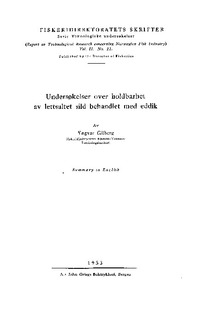| dc.description.abstract | The perishability of mild cured herring products demands special precautions as to temperature during curing to acertain the right degree of taste and texture. With appropriate consideration of transport and «shelflife» before consumption it would be of certain advantage to have a quick and simple method in hand to be able to control the curing process and chose with accuracy the time when the right degree of curing is reached. An earlier work by the same author published in the Series of Technological Research concerning the Norwegian Fisheries, vol. 2 no. 10, undertook to establish figures to find out if the development of trimethylamine nitrogen (TMA-N) and ammonia nitrogen (NH3-N) which is considered as the difference between total volatile nitrogen and TMA-N, compared with an organoleptical estimation of the product could give figures exact enough to form a basis for judgement of the different stages of the curing. The investigations appeared to give a positive answer to the question as far as the analytical figures were found to coincide fairly well with the organoleptical test. As the analytical figures will naturally vary with the special forms of curing (mild salt curing with or without vinegar, salt and sugar curing etc.) it will be necessary later to establish the figures for these curing methods also. The individual variation in TMA values for herring will be of no importance when the brine is analysed, but will give a reliable average value. The Conway Diffusion method is a simple and satisfactory method as to speed and accuracy when applied to the analysis of a large number of samples simultaneously. The present publication is a continuation of the previous one and tries on hand of the same analytical method to establish figures which could enable one to judge the action and effect of different preservatives on mild cured herring products stored at elevated temperatures. The values for TMA-N, which is formed by the action of TMO splitting enzymes formed by certain bacterias active on saltwater fish and form a representative part of the bacterial flora also of salt cured herring, is thought to give an index of the bacterial activity. The difference between total volatile nitrogen and TMA-N which is 95 % ammonia is presumed to give an index of the overall enzymatic activity. Compared with an organoleptical judgement the graphical curves showing the development of NH3-N and TMA-N during storage at + 37° C of herring in brine with different added preservatives seem to give a reliable picture of the difference in effectiveness of the preservatives. The herring with 8 % salt, 6 % sugar and 0,8 % acetic acid content was placed in a jar and covered with 10 % salt brine. The pH of the brine being as an average 5,0. The preservative was then added and the jar was allowed to stand for two days at + 10° C to allow for even distribution and penetration of preservative into the fish before being stored at + 37° C. Samples were taken at regular intervals. The following preservatives were tried: (The figures are percentage of total content of the jar). A. Benzoic acid sodium 0,2 %. B. Benzoic acid sodium 0,2 % + ocylgallat 0,015 %. C. Nipacombin 0,1 %. D. Hexamethylenetetramine 0,1 %. F. Herring previously spiced with 1,4 % of a commercial mixture of spices with added sodiumnitrite (0,25 % of weight of the herring.) The action of the preservatives on account of the analysis of NH3-N and TMA-N was estimated as follows: A. Showing good proteolytic inhibiting action but poor bacteriostatic action. B. A pronouncedly stronger effect than A on the enzymatic as well as on the bacterial activity. C. The bacteriostatic effect is equal to B but as an enzym inhibitor it is noticeably inferior to A and B. D. The evaluation of the action of hexamethylenetramine is influenced by the splitting off of ammonia in an acid medium. As demonstrated by a blind test a solution of 0,1 % hexamethylenetetramine in 0,7 % acetic acid splits off 26 mg of NH3-N/100 ml. Allowing for an adequate reduction of the registered values for NH3-N in D the effect as an enzyme inhibitor appears very good. The bacteriostatic effect is not less than B and C and appears similarly good in comparison. The effect of the preservative is thought to be due at least in part to the liberated equivalent of formaldehyde. F. An apparent prolonging effect of the spice-mixture on storage life of the herring. The effect of the preservatives on the rancidity of the herring fat was analysed through the Kreis red values. C and F showed the lowest values and no rancid odour. B showed a much lower value than A and no rancid odour. A and D were pronouncedly rancid and the Kreis values were from two to three times that of the others. A later publication will demonstrate along similar lines the effect of preservatives and combinations of preservatives on herring cured without acid. | en |
